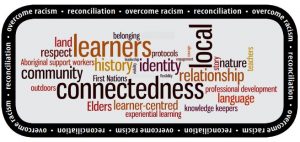
Aboriginal Worldviews and Perspectives in the Classroom: Moving Forward
This guidebook, “Indigenous Worldviews and Perspectives” is a powerful resource. The guidebook starts by discussing two central themes that are key to Indigenous education for all learners. Firstly, strengths-based learner-centered practice that involves educators knowing their students – their interests and strengths. And secondly, overcoming racism that involves decolonizing our thinking, which in part can be done though educator modelling. The guidebook also overviews characteristics of Aboriginal worldviews and perspectives and the implications on teaching practice:
- Connectedness and Relationship
- Awareness and History
- Local Focus
- Engagement with the Land, Nature, the Outdoors
- Emphasis on Identity
- Community Involvement: Process and Protocols
- The Power of Story
- Traditional Teaching
- Language and Culture
- Experiential Learning
- Role of the Teacher
Possible next steps are also included. When looking into Indigenous worldviews and perspectives, why they are important and how to use them in the classroom, this is an excellent resource. One of the most valuable parts of this resources is the quotes from Indigenous peoples who shared their perspectives.